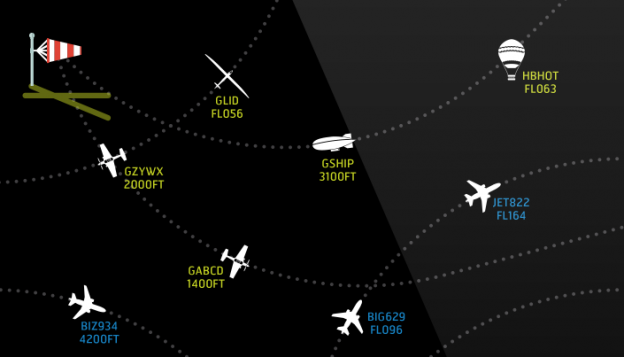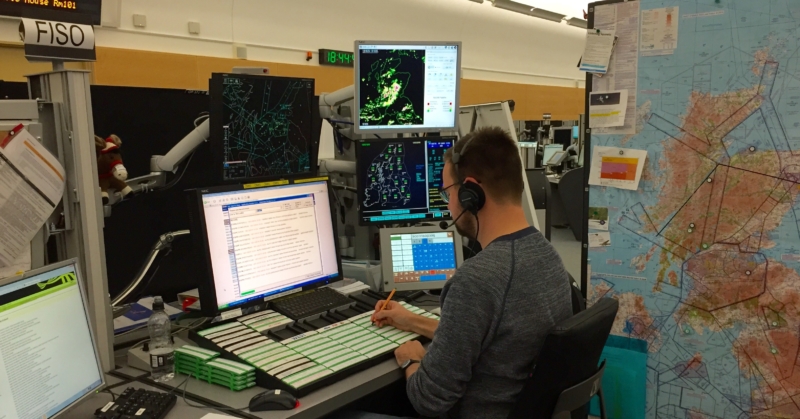As our skies become increasingly busy, we want to create an environment where everyone knows as much as possible about the traffic in the airspace around them, making it safer for all.
Work on collaborative projects with members of the CAA’s Conspicuity Working Group and the SESAR Joint Undertaking are underway with the aim of improving the visibility of general aviation (GA) pilots to each other and to air traffic control through the transmission and reception of 1090MHz Automatic Dependent Surveillance-Broadcast (ADS-B) data.
Automatic Dependent Surveillance – Broadcast (ADS–B) is a surveillance technology in which an aircraft determines its position via satellite navigation and broadcasts it, enabling it to be tracked.
Although we at NATS don’t rely on ADS-B to detect and track aircraft, we want to encourage the GA community to use it because it could support additional capabilities both in the air and on the ground, and make the UK’s busy airspace even safer.
A key aspect of facilitating widespread transmission of ADS-B by GA aircraft is to lower the overall costs involved, and that is where the use of non-certified GPS comes in. For enhancing the ‘see and avoid’ principle, the accuracy provided by a high cost certified GPS source is not necessary and so a lower cost non-certified source can be used instead.
As part of the wider Project EVA work, we initiated a trial with support from the CAA, the Aircraft Owners and Pilots Association (AOPA), the British Microlight Aircraft Association (BMAA) and the Light Aircraft Association (LAA) for GA to transmit ADS‑B using non-certified GPS sources connected to Extended Squitter capable Mode S transponders.
ADS-B data that was collected from the participants’ flights over the six-month trial indicated that the non-certified GPS sources could provide sufficiently accurate position data, meaning it could enhance electronic visibility of GA pilots and enable real safety benefits.
You can read the report from the trial here

Now the trial is complete, the BMAA and the LAA have announced they will continue to approve Mode S Extended Squitter ADS-B installations with non-certified GPS devices. From 18th March, BMAA and LAA’s Avionics Modification Approval processes will take over the ADS‑B verification service from NATS.
Pilots looking to transmit ADS-B from a non-certified GPS source connected to an Extended Squitter capable Mode S transponder, should ensure the modification is conducted by a competent engineer. Visit EASA’s website for more information.
Of course, transmitting ADS-B signals is just half of the story. The next step is to enable aircraft to receive signals from each other. This, it is hoped, will enhance pilots’ ability to see, and be seen and when necessary, avoid other aircraft.
This could be in the form of traffic alerts in the cockpit, enhanced situational awareness displays or even traffic information being spoken directly into a GA pilot’s headset.
Alongside the trial, NATS has been developing the Low Power ADS-B Transceiver (LPAT) for general aviation users that aren’t equipped with a transponder, but still want the safety benefit of transmitting and receiving ADS-B in uncontrolled airspace.
Transponders can be expensive pieces of equipment, which just aren’t suitable for the various, and particularly light-weight, general aviation aircraft, and can be perceived by some pilots to provide little benefit in uncontrolled airspace. LPAT will be a low-cost, easy to fit and carry on product that will allow GA to have electronic visibility of the airspace users around them and importantly, make them visible to others.
Trials and tests of LPAT and other similar devices are underways through Project EVA, a joint initiative between NATS, AOPA, funke and Trig Avonics, and which is co-funded by the SESAR JU.
Lastly, we would like to thank all the participants of the non-certified GPS trial and the support of those who have since declared an interest in transmitting ADS-B from their GA aircraft.
Comments
Please respect our commenting policy and guidelines when posting on this website.

